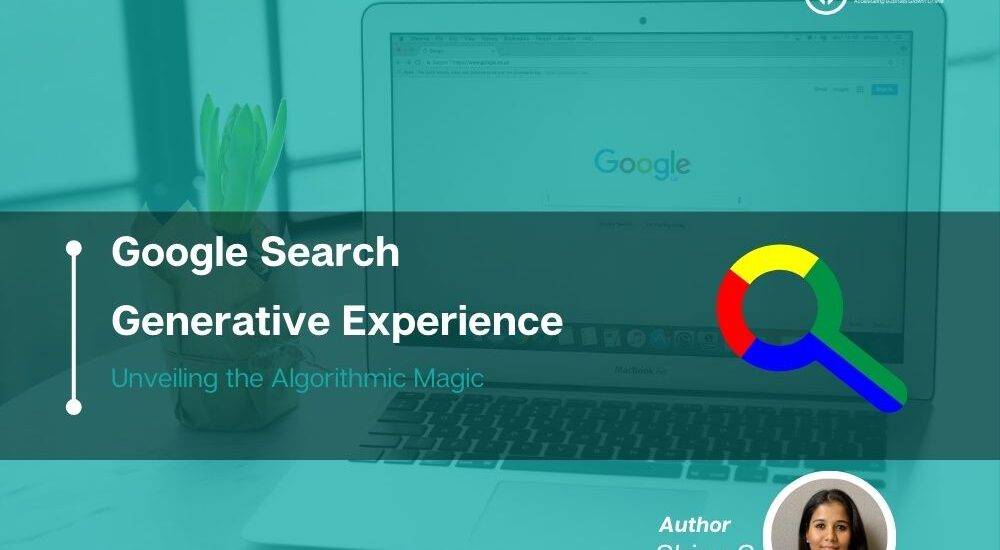Google Search Generative Experience
Unveiling the Algorithmic Magic

In the Digital Era, Google is the go-to search engine for billions of users worldwide. Behind each search query lies a complicated web of algorithms, machine learning models, and user data, collectively known as the Google Search Generative Experience (SGE). SGE is Still in its experimental phase and promises to revolutionize user interaction with search results. This approach utilizes the power of generative AI to create informative summaries and answer snippets directly on the Search Engine Results Page (SERP).
Below in this article, let’s embark on a journey to decode the perplexing world of SGE and its inner workings and reveal the algorithmic magic that powers the search results.
Understanding the Foundations of SGE:
SGE builds upon the determined pursuit of relevance and user satisfaction. Traditional keyword-based searches relied on exact matches between search queries and web page content.SGE employs a multifaceted approach to understand the intent behind each query and deliver personalized results to the user’s context.
Components of SGE:
Ranking Algorithms:
- Google’s ranking algorithms are the heartbeat of SGE.
- It determines the display order of search results.
- PageRank was the pioneer algorithm. Google uses diverse algorithms, including BERT, RankBrain, and neural matching.
- It analyzes content, context, and user signals to deliver relevant results.
Machine Learning Models:
- Machine learning in SGE enables Google to continuously improve its search capabilities and adjust to evolving user behavior and preferences.
- By refined models trained on extensive datasets, Google can better understand natural language, semantic context, and user intent.
- It leads to more accurate and contextually relevant search results.
User Signals and Personalization:
- SGE utilizes mass user signals, like search history, location, device type, and browsing behavior, to personalize each search result for users.
- By user preferences and context, Google can deliver tailored search experiences that predict and fulfill user needs more effectively.
Unveiling the Algorithmic Magic:
Google protects the specifics of its algorithms closely. Some principles and techniques that underpin the algorithmic magic of SGE are:
Natural Language Processing (NLP):
- Google’s advancements in NLP allow it to understand the nuances of human language, including synonyms, context, and user intent.
- SGE analyzes search queries more accurately and matches the user’s intent with NLP, even with wording variations.
Semantic Search:
- SGE is beyond keyword matching to include semantic analysis that enables it to understand the meaning and context of words and phrases within the broader context of a search query.
- The semantic relationships between entities and concepts can deliver more contextually relevant search results in Google.
Contextual Understanding:
- Context is pivotal in SGE. Google strives to understand the explicit meaning of a search query and the implicit context around it.
- Factors like user location, search history, device type, and time of day tailor search results to the user’s specific possibilities and preferences.
User-Centric Ranking:
- Google prioritizes websites and content that align with user needs and preferences to its pursuit of relevance and user satisfaction.
- Content quality, relevance, authority, and user engagement metrics influence the ranking of search results.
The Potential Impact of SGE:
The introduction of SGE has the potential to alter how users interact with search results. Below are some anticipated changes:
Faster Information Recovery:
- Users may find the information they need directly on the Search Engine Result Pages without visiting multiple websites.
- It can significantly improve search efficiency, especially for users seeking quick answers or overviews of a topic.
Evolving User Expectations:
- As SGE becomes more experienced, users might expect concise summaries and points readily available on the SERP.
- It can influence content creation strategies with well-structured, transparent content that facilitates SGE’s analysis.
The Rise of Micro-Moments:
- SGE’s overviews cater to the growing trend of “micro-moments,” where users seek information in bite-sized chunks during brief moments.
- It can lead to a shift in content consumption patterns, with users favoring brief and scannable content.
Optimizing for the SGE Era: Strategies for Success
The specifics of the SGE algorithm remain unrevealed.
Below are some assertive steps to take to ensure the content flourishes in this evolving search landscape:
Focus on User Intent:
- Understanding the “why” behind user searches is essential.
- Research keywords to identify queries users have related to the niche or topic.
- Tailor the content to provide clear, brief, and direct answers to those questions.
Content Quality is Supreme:
- High-quality content is a cornerstone of SEO success, particularly in the age of SGE.
- Focus on well-researched, informative, and trustworthy content that establishes you in the field.
Structured Data and Schema Markup:
- Implement structured data markup on the website for the content’s context and information in Google.
- It significantly improves the accuracy and detail of the SGE summaries generated for the web pages.
Create Content for Featured Snippets:
- Featured snippets are short summaries displayed at the top of the Search Engine Result Pages for specific search queries.
- Optimize the content to appear in featured snippets that can significantly increase the visibility within SGE results.
- Aim for clear, brief answers to frequently asked questions within the content.
Benefits of Search-Generative Experience for Users:
Improved Efficiency:
Users can scan search results faster and determine the websites most relevant to their needs, saving time and effort.
Improved User Experience:
SGE can provide a more streamlined way to find information, especially for users desiring quick answers or overviews of a topic.
Accessibility:
SGE can improve accessibility for users with disabilities or those who prefer a straightforward format for consuming information.
Current Status of Search Generative Experience (March 2024):
It’s essential to remember that SGE is still under development and available through Google Search Labs in the US and only for English language searches active now for user feedback to refine the technology and ensure it delivers accurate and helpful overviews.
Conclusion:
The Google Search Generative Experience represents the conclusion of decades of innovation and expertise in search technology in the algorithmic magic behind SGE as we gain insight into the cultured mechanisms that power Google’s search results and shape the online experiences of billions of users worldwide, unraveling the secrets of SGE, one thing remains clear: understanding and adapting to the principles of relevance, context, and user satisfaction are essential for success in digital search.






